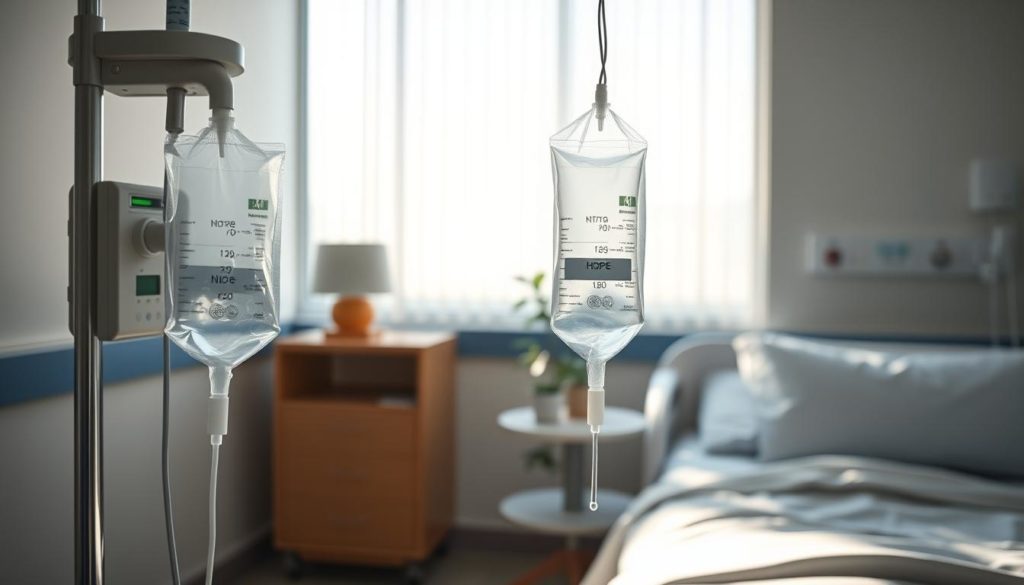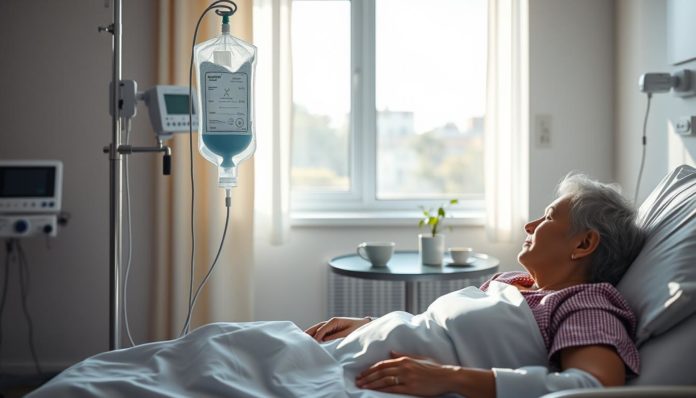Did you know over 228,000 new lung cancer cases are expected in the US this year alone? Chemotherapy is key in treating lung cancer because it targets cells that grow quickly. It’s especially important for small cell lung cancer (SCLC) and different stages of non-small cell lung cancer (NSCLC).
Chemotherapy works by sending drugs through the blood to kill cancer cells. For SCLC, it’s often the main treatment because this cancer type responds well to it. NSCLC treatment may include chemotherapy along with radiotherapy, surgery, and immunotherapy. The choice of treatment and its timing depend on many factors. These include the cancer stage, gene mutations, and how well the patient can handle chemotherapy side effects.
Introduction to Chemotherapy for Lung Cancer
Chemotherapy for lung cancer uses powerful drugs to fight cancer. These drugs target and kill cancer cells. It helps patients at different stages of lung cancer, offering care that aims to cure or make symptoms better.
What is Chemotherapy?
Chemotherapy treats cancer with strong drugs, called anti-cancer or cytotoxic drugs. These drugs spread through the body to reach all cancer cells. Their main aim is to destroy these cells and stop them from spreading further.

How Does Chemotherapy Work?
Chemotherapy targets cells that grow quickly, like cancer cells. The drugs stop these cells from dividing, which kills them. In lung cancer treatment, these drugs might be used by themselves or with surgery and radiation. This combo can shrink tumors, make other treatments work better, and improve life quality.
Types of Lung Cancer Treated with Chemotherapy
Chemotherapy is key in fighting various lung cancers. It’s vital for tackling Small Cell Lung Cancer (SCLC) and Non-Small Cell Lung Cancer (NSCLC). Knowing how these treatments work helps patients and medical teams.
Small Cell Lung Cancer (SCLC)
SCLC spreads quickly and responds well to chemotherapy. SCLC chemotherapy usually starts the treatment. When the cancer hasn’t spread much, doctors add radiation therapy to chemotherapy. This mix boosts the treatment’s impact.
For widespread cancer, doctors use chemotherapy and immunotherapy together. This approach aims to control the cancer’s spread and make outcomes better for patients.

Non-Small Cell Lung Cancer (NSCLC)
NSCLC treatment changes based on the cancer’s stage. Early on, NSCLC chemotherapy supports surgery. It helps kill left-over cancer cells and lowers the chance of the cancer returning. In late stages, chemotherapy combines with other methods. This includes targeted therapy or immunotherapy, tackling the disease from all angles.
In treating both SCLC and NSCLC, chemotherapy drugs are crucial. They bring hope and can greatly enhance the lives of patients.
When Chemotherapy is Used in Lung Cancer Treatment
Chemotherapy is key in treating lung cancer. It changes based on cancer’s stage and specifics, shaped into a lung cancer chemotherapy regimen for each patient.
Neoadjuvant therapy shrinks tumors before surgery. This makes tumors easier to take out. Neoadjuvant therapy boosts surgery success by reducing tumor size beforehand.
Post-surgery, patients often get adjuvant therapy. This step uses more chemotherapy to kill off left-behind cancer cells. It helps prevent the cancer from coming back, offering a deeper healing process.
In late-stage or inoperable lung cancer, chemotherapy is usually the main treatment. It may stand alone or pair with radiation. This strategy aims to curb cancer spread and relieve symptoms.
Here’s a simpler view:
- Neoadjuvant therapy: Shrinks tumors before surgery
- Adjuvant therapy: Targets remaining cancer cells post-surgery
- Advanced stages: Main treatment or combined with radiation
Common Chemotherapy Drugs for Lung Cancer
Knowing about lung cancer chemo drugs is key to finding the best treatments. Both Small Cell Lung Cancer (SCLC) and Non-Small Cell Lung Cancer (NSCLC) get treated with specific medicines. These are based on their unique features.
Drugs for SCLC
For Small Cell Lung Cancer, treatment usually includes different drug combos. Cisplatin or carboplatin are often used with etoposide. These mixes help manage SCLC well. In later stages, doctors may add immunotherapy to get even better results.
Drugs for NSCLC
Treating Non-Small Cell Lung Cancer often means using drugs like cisplatin or carboplatin. These are mixed with pemetrexed or paclitaxel. For advanced NSCLC, this chemo, sometimes with immunotherapy or targeted meds, is best. It’s tailored to the tumor’s genes, making treatment more personal and effective.
How Chemotherapy is Administered
There are different ways to give chemotherapy due to various medical needs and lifestyles. Each method effectively delivers cancer-fighting drugs into the body.
Intravenous Chemotherapy
In intravenous chemotherapy administration, a cannula, central line, PICC line, or portacath delivers medicine right into the bloodstream. This way, the drugs quickly reach cancer cells, making the treatment more efficient.
Oral Chemotherapy
With oral chemotherapy pills, patients easily take their treatment at home. They follow a strict schedule set by their doctor. These pills are just as strong and effective as the drugs given through IV.
Central Lines and Ports
For those getting treatment over a long time, cancer treatment ports and central lines are good options. They are less invasive and reduce the need for repeated needle sticks. This makes treatment more comfortable and lowers the risk of problems.
| Administration Method | Advantages | Considerations |
|---|---|---|
| Intravenous | Quick drug delivery to bloodstream | Requires frequent hospital visits |
| Oral | Convenient home administration | Strict adherence to medication schedule |
| Central Lines and Ports | Comfortable for long-term use | Implantation procedure required |
Combination Treatments with Chemotherapy
Using chemotherapy with other treatments can make it work better against lung cancer. This strategy has been shown to help patients live longer. It helps at different stages of the disease.
Chemotherapy with Radiation
Chemotherapy and radiation therapy together is a strong mix. It’s really good for early-stage lung cancer or if surgery isn’t possible. This mix aims to hit cancer cells hard, working better than using each one by itself.
Chemotherapy with Immunotherapy
More doctors are using chemotherapy with immunotherapy now, especially for certain lung cancers. This works well if the cancer has certain proteins or mutations. It makes the body’s defense stronger against cancer. For more, check the American Cancer Society website.
Chemotherapy and Surgery
Chemotherapy can be used before or after surgery for an extra punch against cancer. Using it before surgery helps shrink tumors, making them easier to take out. After surgery, it helps catch any cancer cells left behind. This way, it fights the disease from all angles.
Chemotherapy for Lung Cancer in Different Stages
Chemotherapy for lung cancer changes a lot based on the disease’s stage. In this part, we’ll look at how chemotherapy helps at various stages. It’s key for managing the disease and helping patients do better.
Early Stage Lung Cancer
Chemotherapy is crucial for early stage lung cancer. It’s often used before or after surgery. Before surgery, it makes tumors smaller and easier to remove. After surgery, it kills off any remaining cancer cells to prevent the cancer from coming back. This technique boosts the chance of success and long-term remission.
Advanced Stage Lung Cancer
In advanced stages, including stage IV, the approach is more aggressive. At this point, chemotherapy is vital to control the disease and relieve symptoms. It’s usually combined with newer treatments like targeted therapy and immunotherapy. This helps increase its effectiveness and improves patients’ lives. The treatment plan is customized for each patient’s needs.
- Neoadjuvant Therapy: Chemotherapy before surgery to reduce tumor size.
- Adjuvant Therapy: Post-surgery chemotherapy to prevent cancer recurrence.
- Combination Therapy: Using chemotherapy alongside targeted therapy or immunotherapy to combat advanced cancer stages.
Common Side Effects of Chemotherapy
Chemotherapy can cause a range of side effects. Knowing what these are and how to deal with them can make a big difference in a patient’s life.
Short-Term Side Effects
Some short-term effects of chemotherapy are hair loss, nausea, vomiting, and mouth sores. Changes in blood cell counts may also occur.
These changes can increase the risk of infections, cause bruising or bleeding, and make one feel tired.
Long-Term Side Effects
Certain side effects from chemotherapy can last a long time. Nerve damage, or peripheral neuropathy, is one such lasting effect. Keeping an eye on the patient’s condition is key to managing these long-term effects well.
Managing Chemotherapy Side Effects
To manage side effects, doctors may prescribe medicines to prevent nausea. They also check blood levels regularly. Adjusting the doses based on these levels can help with quick and effective treatments. This improves the overall success of the therapy.
| Side Effect | Type | Management Strategies |
|---|---|---|
| Nausea | Short-term | Prophylactic Medications |
| Infection Risk | Short-term | Blood Parameter Monitoring |
| Peripheral Neuropathy | Long-term | Ongoing Monitoring and Adjustments |
Duration and Cycles of Chemotherapy Treatment
The duration and cycles of chemotherapy for lung cancer vary for each patient. This depends on the cancer’s type and stage, and the drugs used. Cycles involve active treatment followed by a break for recovery. This helps the drugs work well and gives the patient’s body time to heal.
For early-stage lung cancer, treatment over a few months is common. Adjuvant chemotherapy is used after surgery to kill any left cancer cells. Neoadjuvant chemotherapy is applied before surgery to make tumors smaller. These methods aim to increase the chance of fully recovering. They usually consist of four to six cycles, each lasting around three to four weeks.
In advanced lung cancer cases, chemotherapy cycles are longer and more complex. The initial cycles aim to control the spread of cancer. Then, maintenance therapy is often started. It keeps the cancer in check or manageable as long as it works for the patient. Maintenance therapy may use lower doses or different drugs for long-term treatment.
FAQ
What is Chemotherapy?
Chemotherapy uses drugs to destroy cancer cells in the blood. It is vital for treating lung cancer, especially small cell lung cancer (SCLC). SCLC is very sensitive to these treatments.
How Does Chemotherapy Work?
Chemotherapy targets and destroys fast-growing cancer cells. It travels through the blood to reach cells all over the body.
What Types of Lung Cancer Are Treated with Chemotherapy?
Both small cell lung cancer (SCLC) and non-small cell lung cancer (NSCLC) are treated with chemotherapy. SCLC responds well because it spreads fast. NSCLC’s response depends on the cancer stage and other factors.
When is Chemotherapy Used in Lung Cancer Treatment?
Chemotherapy might be used before surgery to shrink tumors. It can also be used after surgery to kill any left cancer cells. Or as the main treatment when lung cancer can’t be operated on.
What Are Common Chemotherapy Drugs for Lung Cancer?
In SCLC, drugs like cisplatin or carboplatin plus etoposide are common. NSCLC may use the same drugs with pemetrexed or paclitaxel. For advanced stages, doctors might add immunotherapy or drugs that target specific gene changes.
How is Chemotherapy Administered?
Chemotherapy can be given through an IV or as pills. IV chemotherapy uses a needle, a central line, a PICC line, or a portacath. Pills or capsules are taken on a schedule.
Can Chemotherapy Be Combined with Other Treatments?
Yes, it’s often used with radiation (chemoradiotherapy), immunotherapy, or surgery. Combining treatments can lead to better results in fighting lung cancer.
How is Chemotherapy Used in Different Stages of Lung Cancer?
For early-stage lung cancer, chemotherapy can be given before or after surgery. This helps stop the cancer from coming back. In advanced cancer, it controls the spread and improves life quality.
What Are the Common Side Effects of Chemotherapy?
Side effects can include losing hair, feeling sick, mouth sores, and changes in blood cells. This might increase the risk of infections, bruising, bleeding, and feeling very tired. Some effects, like nerve damage, can last a long time.
How Long Does Chemotherapy Treatment Last?
Treatment length and cycles depend on the cancer’s type and stage, and the drugs used. It’s usually given in cycles, with breaks in between. For early-stage cancer, treatment might last months. Advanced cancer may need ongoing treatment.


